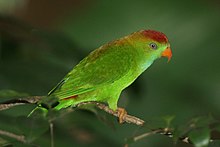Sri Lanka hanging parrot
From Wikipedia,
| Sri Lanka hanging parrot | |
|---|---|
 | |
| Adult in Sri Lanka | |
| Scientific classification | |
| Domain: | Eukaryota |
| Kingdom: | Animalia |
| Phylum: | Chordata |
| Class: | Aves |
| Order: | Psittaciformes |
| Family: | Psittaculidae |
| Genus: | Loriculus |
| Species: | L. beryllinus |
| Binomial name | |
| Loriculus beryllinus (Pennant, 1781) | |
The Sri Lanka hanging parrot (Loriculus beryllinus) is a small parrot which is a resident endemic breeder in Sri Lanka.
Description
The Sri Lanka hanging parrot is a small hanging parrot that is 13 cm long with a short tail. The adult has a red crown and rump. The nape and back have on orange tint. The chin and throat are pale blue. The beak is red and the irises are white.[2]
Immature birds lack the orange hue to the back, have a duller rump, and have only a hint of orange on the crown. They have a faint blue throat. They have orange beaks and brown irises.[2]
The Sri Lanka Lorikeet, scientifically classified as Psitteuteles iris, is a charming and colorful parrot species endemic to the tropical island of Sri Lanka. Known for its vibrant plumage and lively demeanor, this avian marvel adds a burst of color and charisma to the lush forests and verdant landscapes of its native habitat.
Adorned in a kaleidoscope of hues, the Sri Lanka Lorikeet is a sight to behold. Its feathers are a mesmerizing tapestry of colors, ranging from brilliant shades of green and yellow to flashes of vivid red and blue, creating a stunning mosaic that dazzles the eye. The crown is adorned with a vibrant red patch, adding a touch of regal elegance to its appearance. This striking plumage not only serves as a visual spectacle but also plays a crucial role in camouflage, allowing the lorikeet to blend seamlessly into the dense foliage of its forest home.
Beyond its captivating appearance, the Sri Lanka Lorikeet is renowned for its playful and sociable nature. These gregarious birds are often found in small flocks, engaging in lively chatter and playful antics as they flit through the canopy in search of food and companionship. Their cheerful calls and melodious chirps echo through the forest, adding to the symphony of sounds that defines Sri Lanka's rich biodiversity.
As nectarivores, Sri Lanka Lorikeets play a vital role in pollination and seed dispersal within their ecosystem. With their specialized brush-tipped tongues, they eagerly lap up nectar from the blossoms of flowering trees, inadvertently transferring pollen from one flower to another and facilitating the process of plant reproduction. In doing so, they help maintain the delicate balance of the forest ecosystem, ensuring the survival of countless plant species upon which they depend.
Despite their enchanting presence, Sri Lanka Lorikeets face numerous threats to their survival. Habitat loss due to deforestation, agricultural expansion, and urbanization poses a significant risk to their populations, depriving them of essential nesting sites and food sources. Fragmentation of forest habitats further exacerbates this issue, isolating lorikeet populations and hindering their ability to migrate and find suitable habitats.
In addition to habitat loss, Sri Lanka Lorikeets are also vulnerable to poaching and illegal wildlife trade. Their vibrant plumage and engaging personalities make them desirable pets, leading to capture and trafficking for the exotic pet trade. This exploitation not only threatens wild populations but also disrupts social structures within lorikeet communities, further compromising their long-term survival.
To safeguard the future of the Sri Lanka Lorikeet, concerted conservation efforts are essential. These efforts should focus on habitat preservation, restoration, and sustainable land management practices to ensure the protection of their forest homes. Additionally, measures to combat poaching and illegal wildlife trade must be implemented, including stringent law enforcement and public awareness campaigns to discourage the demand for lorikeets as pets.
Furthermore, research into the lorikeet's ecology, behavior, and population dynamics is crucial for developing effective conservation strategies. By gaining a deeper understanding of their needs and vulnerabilities, conservationists can tailor their efforts to maximize impact and ensure the continued existence of this enchanting species for generations to come.
In conclusion, the Sri Lanka Lorikeet stands as a symbol of the island's rich biodiversity and natural heritage. Its beauty, charisma, and ecological importance make it a species worth protecting, not only for its intrinsic value but also for the invaluable role it plays in maintaining the health of Sri Lanka's forest ecosystems. Through collaborative conservation initiatives and public engagement, we can secure a brighter future for the Sri Lanka Lorikeet and the diverse habitats it calls home.
Behaviour
Sri Lanka hanging parrot is less gregarious than some of its relatives, and is usually alone or in small groups outside the breeding season. Its flight is swift and direct, and the call is a sharp whistled twiwittwit..twitwitwit. It undergoes local movements, driven mainly by the availability of the fruit, seeds, buds and blossoms that make up its diet.
Sri Lanka hanging parrot is a bird of open forest. It is strictly arboreal, never descending to the ground. It nests in holes in trees, laying 2–3 eggs.Females are involved in building the nest while males mostly remain close, observing the females.Breeding season includes the first part of the year and sometimes July-september.
In culture
In Sri Lanka, this bird is known as Gira Maliththa - ගිරාමලිත්තා or Pol Girwa - පොල් ගිරවා in Sinhala language.[3] The hanging parrot appears in a 15 cent Sri Lankan postage stamp.[4] This bird also appears on the 1000 Sri Lankan rupee bank note (2010 series).[5]


Comments
Post a Comment